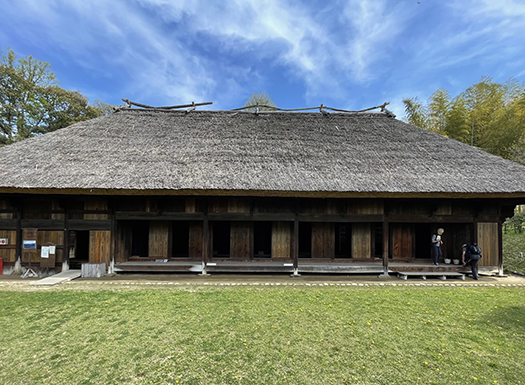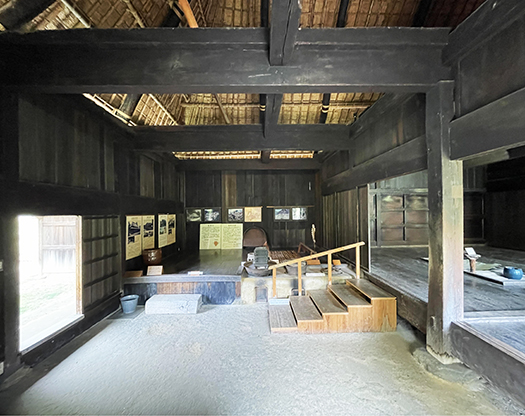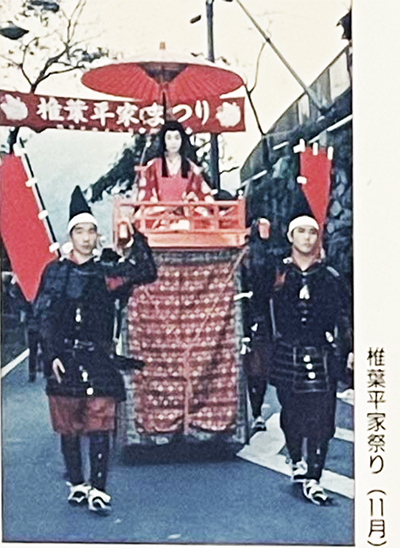わたしとしては能登の時国家住宅以来の「平家落人」の住宅。まぁほかにも四国の古民家でそういう伝承だけはある家も見たのですが、本格的な集落ごと、その伝承を色濃く持っているものは2件目。
上の写真はこの移築住宅の説明パネルより。毎年11月に「椎葉平家祭り」という祭礼が行われる。地元には平家所縁の神社である「厳島神社」が勧請されている。源平の争乱によって日本の神社の中では「八幡」神が多数になったけれど、平家が制していれば厳島神社が多数、興っていたのかもしれない。
その祭礼に際して神輿の上にひとりの女性が登場する。その父親が清盛の子どもたちの内の誰であるのかは不明。彼女はこの落人集落統合のひとつの象徴のような存在で「鶴富姫」とされている。
伝承では平清盛の「孫娘」。平家一統にとってこの椎葉まで逃れてきてなお統合を維持してきたのは、こうした貴種への崇拝もあったのだろう。GoogleMapで見てもかなりの秘境。
後に日本民俗学の祖とされる柳田國男氏がこの地を訪れそのあと、遠野に行ったということで深く民間伝承が残り岐阜県白川・徳島県祖谷と「日本三大秘境」とされるけれど、源氏方の探索はきびしく行われ、頼朝からの命令で那須与一が「討伐」を命ぜられたという。しかし与一は病気としてその弟の那須宗久〜通名「大八郎」が山深いこの地まで攻め寄せたという。
パネルの説明文では、「戦意を失いひっそりと平和に暮らす落人たちを見て討伐をやめた」と書かれている。そして「やがて大八郎は鶴富姫と恋仲に成り、この地に永住を決意します。ところが鎌倉から帰還の命令が下り別れが来ます。そのときすでに鶴富姫は身ごもっており、もし男子ならば那須家の本願地・下野まで送るように、女子ならばこの地で育てよ、と言い残して去って行った」という。生まれた子は女子だったのでこの地で育ち、婿を取って名跡は「那須」姓を名乗って代々、この地を支配したというのだ。


地元に残る伝承説話であり、この地域の支配者であった平家の流れを汲む貴種についての話なので、その立場から真相は改竄されている可能性が高いだろう。わたし的には鶴富姫と言う存在が落人たちの行く末を考えていわば「自己犠牲的」に身を捧げた説話と感じた次第。
敵の攻撃軍の首領に身を捧げ、なおかつ生まれた子孫にもその名跡を名乗らせたということが、この地での「平和構築」にとってどれほど偉大な決断であったかと偲ばれる。
さらにそういった共有の「思い」がこの落人集落の永続性を担保しつづけたのではないか。自ら身を捧げて一族を守る厨子王の姉「安寿」たらんとしたのだろうか。女性は偉大だと深く思わされる。
English version⬇
Legend of Kiyomori’s Granddaughter and Her Brother Yoichi Nasu, a Heike Rakunin Family in Hyuga-2
Did the princess, who was a noblewoman related to Kiyomori and could have been a court noble if she had been in the capital, self-sacrificingly devote herself to an enemy general? Yasutoshi and Kurashioh? …
For me, this is the first “Heike Orachito” house I have seen since the Tokikoku residence in Noto. Well, I have seen other old minka houses in Shikoku that have only such traditions, but this is the second one that has a full-fledged village with its own traditions.
The photo above is from the explanatory panel of this reconstructed house. Every year in November, a festival called the “Shiiba Heike Festival” is held. Itsukushima Shrine, a shrine related to the Heike family, is recommended to the local people. Although the Genpei wars have made the “Hachiman” deities predominate among Japanese shrines, many Itsukushima shrines might have sprung up if the Heike had been in control of the area.
On the occasion of the festival, a woman appears on top of a portable shrine. It is not known who her father was among Kiyomori’s children. She is said to be “Tsurutomi Hime,” a symbol of the integration of the Ochinin community.
According to tradition, she is the “granddaughter” of Taira no Kiyomori. The Heike line escaped to Shiiba and still maintained their unity, probably due to the worship of such a noble species.
Kunio Yanagida, who later became the founder of Japanese folklore, visited this area and later went to Tono, so it is considered one of Japan’s three most secluded areas, along with Shirakawa in Gifu Prefecture and Iya in Tokushima Prefecture, where folklore remains. However, Yoichi was ill, and his younger brother Munehisa Nasu, known as “Daihachiro,” attacked this area deep in the mountains.
The explanation on the panel reads, “He saw the fallen soldiers who had lost their will to fight and were living peacefully, so he decided not to attack them. Daihachiro eventually fell in love with Princess Tsurutomi and decided to live here permanently. However, the order to return came from Kamakura and they parted. If it was a boy, he told her to send him back to Shimono, the Nasu family’s main residence, and if it was a girl, he told her to raise the child here. Since the child was a girl, she grew up in this area, and she took a son-in-law and assumed the family name of “Nasu” and ruled the area for generations.
The story is a local legend about a noble descendant of the Heike clan that ruled the area, so the truth is likely to have been falsified from that standpoint. In my opinion, the story is about Tsurutomihime, a woman who sacrificed herself for the fate of the fallen soldiers.
I can only imagine how great a decision it must have been for the “peace-building” of this land to have offered herself to the leader of the enemy’s attacking army and to have her descendants bear the name of the leader.
Furthermore, such shared “feelings” may have continued to ensure the permanence of this Ochijin community. I wonder if she devoted herself to become “Anju,” the elder sister of King Zurikio, who protected the family. It makes me think deeply of the greatness of women.
Posted on 6月 2nd, 2024 by 三木 奎吾
Filed under: 歴史探訪









コメントを投稿
「※誹謗中傷や、悪意のある書き込み、営利目的などのコメントを防ぐために、投稿された全てのコメントは一時的に保留されますのでご了承ください。」
You must be logged in to post a comment.